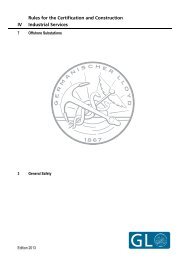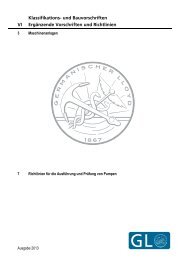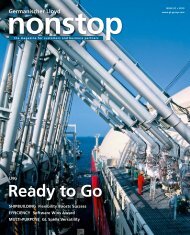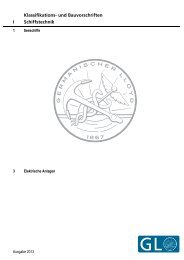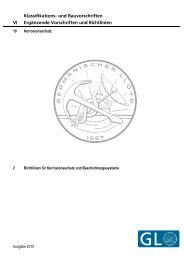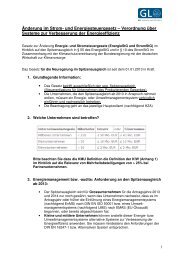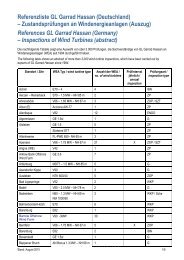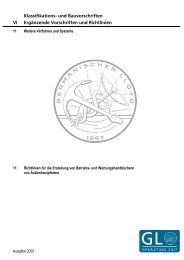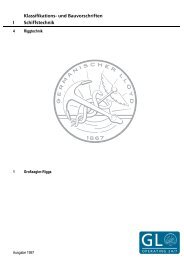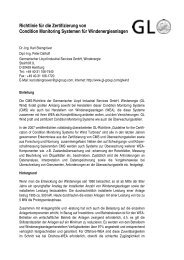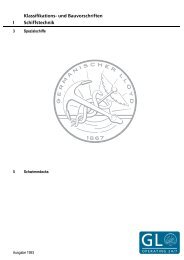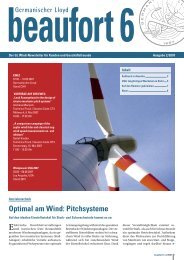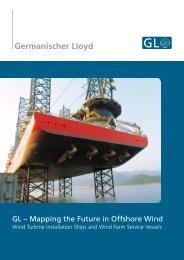Protection of Fuel Tanks Safety ahead! - GL Group
Protection of Fuel Tanks Safety ahead! - GL Group
Protection of Fuel Tanks Safety ahead! - GL Group
You also want an ePaper? Increase the reach of your titles
YUMPU automatically turns print PDFs into web optimized ePapers that Google loves.
BACKGROUND<br />
Finite Elements: Computing to Achieve Equilibrium<br />
What do a heavily loaded cargo ship in heavy seas and a Formula I<br />
racing car taking a curve at 170 km/h have in common? As different as<br />
these two situations may appear, it is not only the individuals steering<br />
these vehicles that are put to the test, but also the vehicles themselves.<br />
Both the ship and the car are travelling in a borderline situation that exposes<br />
their materials to extreme stress. It is the engineer’s job to design<br />
the vehicles so they will withstand these borderline stress loads.<br />
There are numerous mathematical approaches to determine the<br />
relationship between force and deformation so as to properly dimension<br />
each basic component. But frequently these methods are inadequate for<br />
real-life requirements, especially so in complex structures. How can an<br />
engineer manage this seemingly impenetrable mess <strong>of</strong> loads, points <strong>of</strong><br />
application <strong>of</strong> force, and section moduli?<br />
Small solutions. The answer is a scientifi c method that breaks up<br />
large problems into many individual partial problems that are fi rst solved<br />
independently. All these small solutions can then be merged into one<br />
big solution. This is what the fi nite-element method (FEM) is all about. It<br />
owes much <strong>of</strong> its success to the introduction <strong>of</strong> powerful yet affordable<br />
computers that can handle the enormous amounts <strong>of</strong> individual calculations<br />
involved in this method.<br />
Big system. Simply put, the FEM substitutes a virtual structure <strong>of</strong> a<br />
large but fi nite number <strong>of</strong> individual, simple elements assumed to have<br />
simple elastic properties for the specifi c component. These elements are<br />
assumed to be interconnected at individual points called nodes. Loads<br />
and the resulting deformation <strong>of</strong> the elements cause node movements or<br />
forces within the structure. The challenge consists in creating an equilibrium<br />
between these inner forces and the external forces. This leads to an<br />
enormous equation system that <strong>of</strong>ten comprises hundreds <strong>of</strong> thousands<br />
<strong>of</strong> elements and can be solved to produce the desired values. A job for<br />
Mr Silicon: many computer applications today use the FEM.<br />
services and its team <strong>of</strong> about 50 mechanical engineers, naval<br />
architects, physicists and mathematicians. On-site service<br />
teams at locations around the globe, such as Ulrich Behrens<br />
in Shanghai, pr<strong>of</strong>it from this network tremendously.<br />
“We go wherever we are needed,” says Karsten Fach, Head<br />
<strong>of</strong> Engineering Services at <strong>GL</strong>. Modern means <strong>of</strong> communication<br />
are important prerequisites for rapid analysis and<br />
problem-solving, he emphasizes.<br />
Unique Expertise<br />
One <strong>of</strong> the key competence areas that enable <strong>GL</strong> to deliver<br />
its unique customer focus is structural strength. With <strong>GL</strong><br />
ShipLoad, Germanischer Lloyd <strong>of</strong>fers a user-friendly program<br />
for computing load spectra for reliable finite-element<br />
analysis (FE analysis, see info box) <strong>of</strong> a ship. Using the<br />
graphical user interface, ship, wave and cargo parameters<br />
can be applied to the FE model quickly and reliably; hydrographic<br />
and hydrodynamic calculations are integrated.<br />
The calculation process provides the designer with selected,<br />
substantiated and realistic load assumptions for optimal<br />
dimensioning <strong>of</strong> the hull based on the given requirements.<br />
Another s<strong>of</strong>tware product that supplies Engineering<br />
Services with outstanding results is the <strong>GL</strong> ShipModel application<br />
for hull design – an extension developed in-house<br />
<strong>of</strong> the widely used MSC.Patran package, and a pioneering<br />
Foto: Eberhard Petzold<br />
Foto: Renault<br />
CHINA | MARITIME SERVICES<br />
achievement in many ways. “The development <strong>of</strong> structural<br />
models for analyzing strength, vibrations and ship acoustics<br />
is not supported by any commercial s<strong>of</strong>tware vendor,”<br />
Karsten Fach says.<br />
Another new trail was blazed when <strong>GL</strong> engineers developed<br />
a high-speed trimaran 130 meters in length. Initially,<br />
there was no experience available, nor were there any established<br />
rules covering the envisaged ship design. What to<br />
do? In the end, the <strong>GL</strong> specialists paved the road to success<br />
by combining computational fluid dynamics derived from<br />
the world <strong>of</strong> automotive engineering with their experience<br />
gained from other ship types.<br />
Precisely this is what distinguishes <strong>GL</strong>’s Engineering<br />
Services, Karsten Fach explains. “We make our own<br />
developments with our own staff, thereby achieving a level<br />
<strong>of</strong> subject-specific know-how that is simply unique worldwide.”<br />
But <strong>GL</strong> does not guard this expertise jealously. “It is my<br />
job to pass on the knowledge,” says <strong>GL</strong>’s Shanghai expert,<br />
Ulrich Behrens. To this end, he is currently working on the<br />
presentation documents for the first vibration seminar to<br />
be held by the <strong>GL</strong> Academy – an Asian debut. ■ JI<br />
For further information: Ulrich Behrens, <strong>GL</strong> Engineering Services Shanghai,<br />
Phone: +86 138 16504332, E-Mail: ulrich.behrens@gl-group.com<br />
nonstop 4/2006<br />
31



